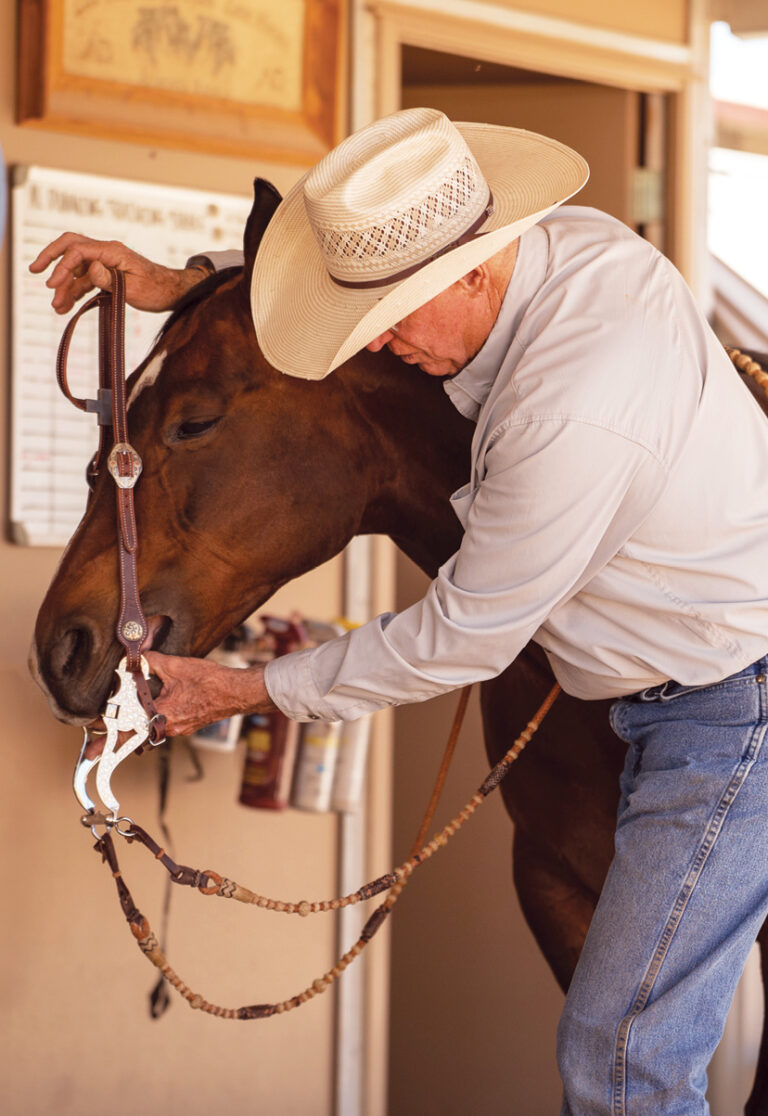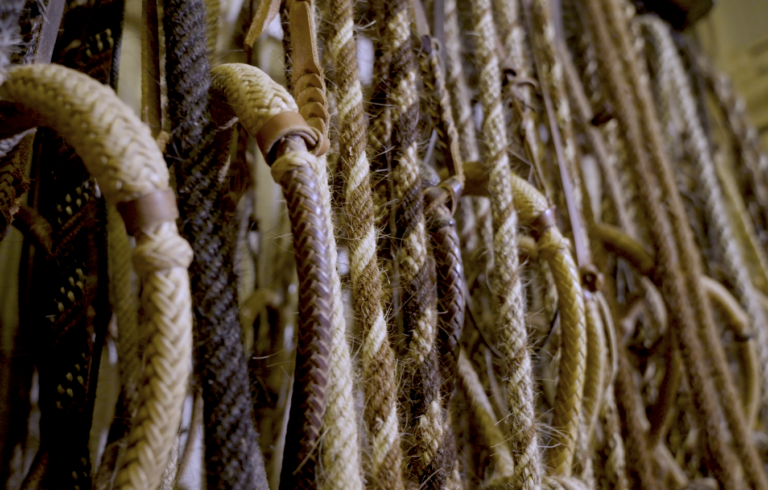There’s nothing more classically Western than a handsome, well-made hackamore. The bitless setup—which includes a bosal, hanger, and mecate—is used by riders as an everyday riding tool, a training aid, or as a means to transition from a snaffle bit to a bridle. It can drastically improve your horse’s training if used correctly.
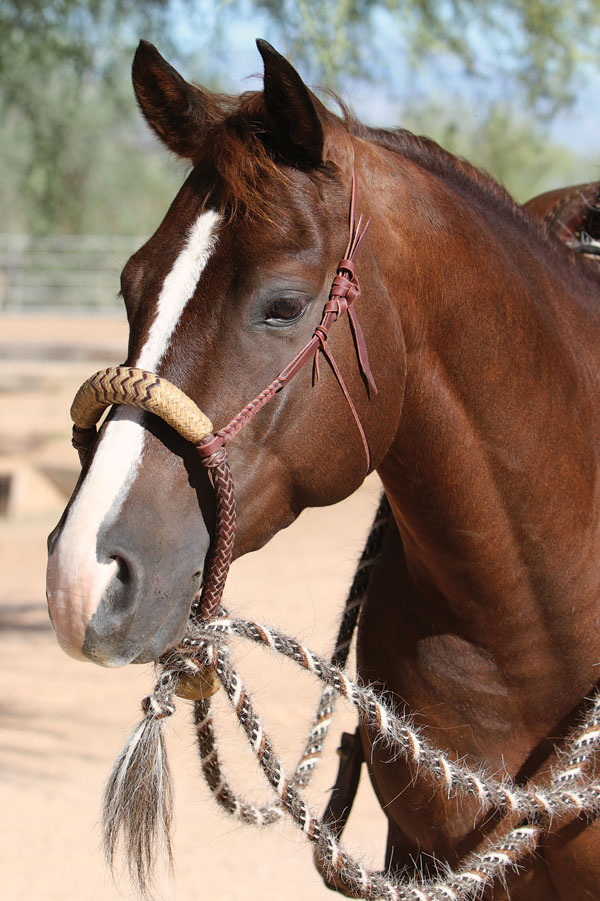
Here, you’ll learn the ins and outs of the traditional hackamore, including its anatomy, use, and best care practices. Equipped with this information, you’ll be able to use a hackamore to improve your horse’s feel and enhance your horsemanship.
The Setup
The hackamore is comprised of multiple components that can be found in a range of materials and styles. Before you outfit your horse, learn his temperament and preferences, and then choose a hackamore that’ll complement him.
The bosal is the oval or teardrop-shaped noseband. It’s made of rawhide, rope, leather, or combinations of these, and traditionally has a rawhide core. It’s measured in plaits, which refers to the number of strands used in the braiding process, and is found in diameters between ½ and 1 inch. The flex of a bosal refers to its ability to return to shape after being used or bent.
The mecate is a single line of rope made of horse hair or other material. The 22-foot long rope ties above the heel knot to create reins and an accompanying lead line. You can tie the mecate to adjust the bosal, making the bosal tighter or looser to best fit your horse’s nose.
The heel knot is the lower, balancing portion of the bosal that connects the cheekpieces together and sits just underneath your horse’s jaw.
The nose button is the portion of the bosal that goes over the bridge of your horse’s nose. In bosals where the entire piece isn’t made of the same material, the nose button is the thickest, most visible portion. The nose button seen in the first photo is narrow. Because of this, a jowl string can be used to keep the hanger from riding up your horse’s face and into his eyes.
The hanger or cheek is the adjustable, soft-leather strap headstall piece that runs behind the horse’s ears and attaches to the bosal on either side of his face.
Use
A hackamore applies pressure to your horse’s nose by rocking back and forth across its bridge. Because the reins attach to the same location underneath his jaw, clear cues are crucial. Unlike with a snaffle bit, which allows you to use direct rein to cue for lateral movement, the hackamore requires finesse so shouldn’t be used as a fix-all for a horse that’s unresponsive to a bridle or snaffle bit. But in the right hands, and with a horse that already has a sound foundation in his training, the hackamore can help teach your horse to be more free and responsive.
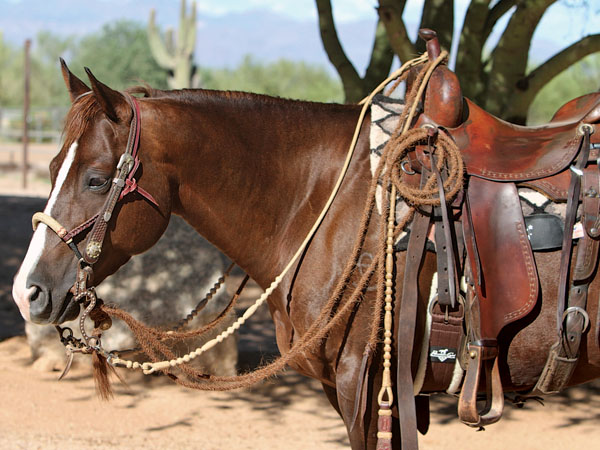
To introduce the hackamore to your horse, first get him accustomed to it on the ground. The feel on his nose will be different than anything he’s accustomed to, so allow him to get a firm understanding of how it moves and applies pressure before training in it. Keep in mind that steady, even pulling from both reins will only brace the bosal against the bridge of his nose and eliminate the play or rocking. This’ll teach him to brace against the hackamore or become resistant to your cueing, which will undo your training. Instead, use single-side pressure and a supporting neck rein.
Fit
There are three factors to consider when outfitting your horse in his hackamore, including the fit of the bosal or nosepiece, the mecate, and the hanger.
The bosal varies in size, thickness, and pliability. The size that’s appropriate for your horse depends on his preference. A light, small-diameter nosepiece is best for feely, sensitive horses. A bigger, stronger bosal is suitable for a horse that needs a little more signal. A bosal with more play on the horse’s nose will result in a stronger cue.
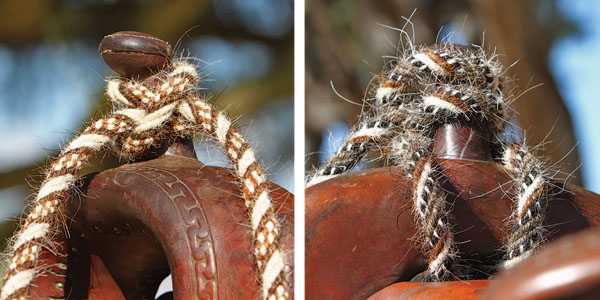
The mecate should be tied in a way such that there’s enough space in the noseband to allow the bosal to rock back and forth on the horse’s nose. The more wraps you put in the mecate (around the heel knot at the bottom of the bosal), the smaller the nose space will be. There should be enough room between the bosal and your horse’s face that you can easy slide your index finger in the space. The mecate also shouldn’t be tied so loosely that when you pull on the reins, the bosal slides up your horse’s face. This won’t allow for effective cueing. Allow room for it to slide nearly halfway between your horse’s jaw and muzzle for appropriate adjustment.
The hanger should be adjusted so that the nosepiece sits just above the bridge of your horse’s nose. If it’s too low, it’ll restrict his airway; too high and it won’t have room to move and transfer cues.
Care
Mindful care and maintenance of your hackamore will ensure that it keeps its shape and lasts. Keep the entire hackamore, including the hanger, mecate, and nosepiece clean. Brush off dirt or hair that’s accumulated during your ride, and use rawhide cream on all rawhide pieces.
Before storing, loosen the mecate. If you hang up your hackamore with the mecate still tight, there’s a chance that the hackamore will twist and lose its shape. If it tends to become too narrow when left unused, whittle a stick that can be fixed across the inside of the nose and hold it open. Or, store it with the noseband placed around an empty coffee can or oatmeal canister to encourage it to maintain good shape.
Purchase hackamores on Amazon!
Products we feature have been selected by our editorial staff. If you make a purchase using the links included, we may earn a commission. For more information click here.
Al Dunning, Scottsdale, Arizona, has produced world champion horses and riders in multiple disciplines. He’s been a professional trainer for more than 40 years, and his expertise has led him to produce books, DVDs, and his own online mentoring program, Team AD International (teamadinternational.com).

